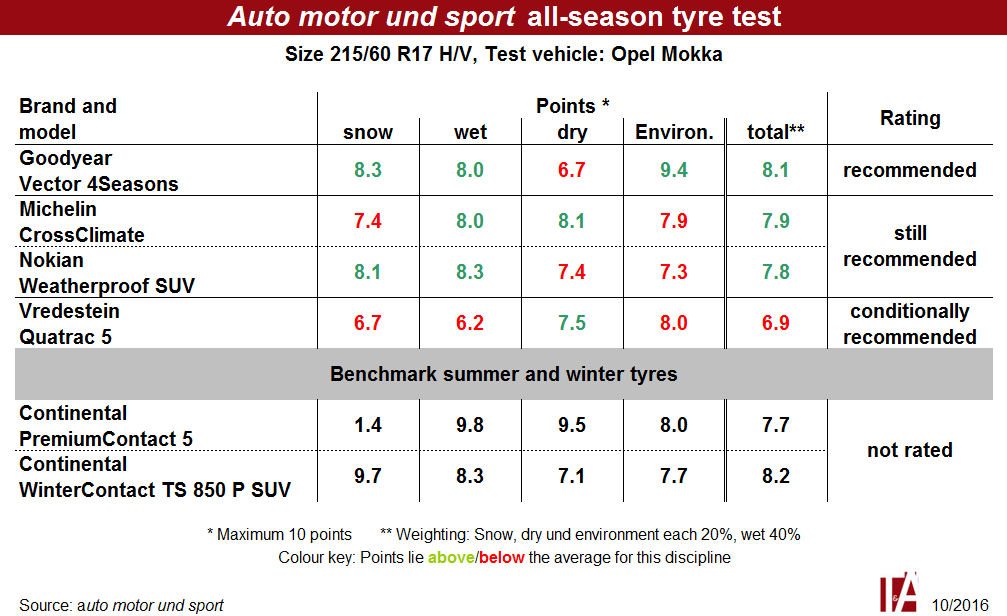All-season tyres fail to shake compromise stigma in German test

A recent comparative test of all-season tyres from Germany suggested these products deliver less than optimal performance when driven on dry roads. The question of all-season versus dedicated seasonal fitments has once again arisen in the latest tyre test from auto motor und sport magazine. In this evaluation of four size 215/60 R17 H/V tyres – the sort of rubber often found on SUVs such as the VW Tiguan, Skoda Yeti or Vauxhall Mokka (which served as test vehicle) – only one protagonist gained the top ‘recommended’ rating.
The tyres auto motor und sport tested are the Goodyear Vector4Seasons, Michelin CrossClimate, Nokian Weatherproof SUV and Vredestein Quatrac 5; the quartet were scrutinised alongside summer and winter reference tyres, the Continental PremiumContact 5 and WinterContact TS 850 P SUV. The tyres were tested on dry, wet and snow-covered road surfaces and for environmental criteria. The wet weather disciplines alone counted for 40 per cent of the total; auto motor and sport gave wet testing a heavy weighting as wet road surfaces are a factor to contend with all year round.
The Goodyear Vector4Seasons arguably coped with the balancing act between the various road conditions better than its three competitors even though it scored the least points for the dry disciplines. The Goodyear rubber was described as an “easy to handle and good-natured understeering tyre on snow” with “acceptable dynamics in the wet, stable and competent cornering dynamics on dry surfaces.” Yet the test winner also displayed weaknesses such as a “long stopping distance and low reserves in the dry” and also deficits “when it comes to lateral control in the wet or during longitudinal aquaplaning.” The Vector4Seasons finished the test with 8.1 out of ten points and was deemed a “winter-oriented all-weather tyre with exemplary low rolling resistance.”
The second-placed Michelin CrossClimate scored 7.9 points even though, as commented auto motor and sport, summer characteristics were more a development focus for the tyre than winter. This emphasis was seen in the CrossClimate’s strong performance in the dry, and while the Michelin tyre’s wet performance received the same score as the Goodyear rubber, it couldn’t match the Vector4Seasons in the winter disciplines. The CrossClimate was rated ‘still recommended’.
This particular rating was also given to the Nokian Weatherproof SUV, which scored 7.8 points out of ten. The Nokian tyre’s strengths included traction and braking on snow, balanced wet characteristics and direct, fast and secure lane changing. The tyre was marked down for sensitivity to changes of load in wet and snow conditions and a long braking distance in the dry. The Weatherproof SUV was considered a more winter-oriented tyre.
On the other hand, the strengths fourth-placed tyre were positioned towards the summer end of the scale. The Vredestein Quatrac 5 was considered “to some extent the most sporting all-weather tyre” in the auto motor und sport test, and it performed well on dry road surfaces, picking up points for cornering dynamics and driving stability. However the testers noted a “significant misunderstanding between lateral control and traction in the snow” and criticised the Quatrac 5 for a “too long a stopping distance, particularly on dry and wet surfaces.” These drawbacks led to the Vredestein tyre finishing the test with a “conditionally recommended” rating and 6.9 out of ten points. Auto motor und sport wrote that the Quatrac 5 could “not quite keep pace” with the other three tested tyres.
The presence of summer and winter reference tyres again highlighted the question of whether all-season tyres remain a compromise despite the many improvements made in this segment. The absence of a ‘highly recommended’ test candidate indicates that auto motor und sport considers this the case, and in regards to maximum safety at each time of the year, the publication states that specific summer and winter tyres are the “better choice.”


Comments